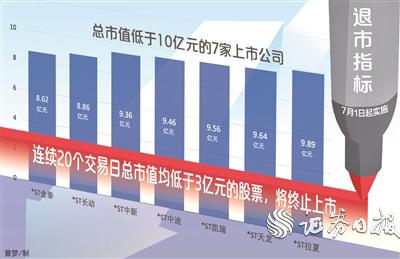The "300 million yuan market value" delisting index will be implemented in July for small market value companies or marginalization
Our reporter Chang Xiaoyu
There are only 2 trading days left before the delisting index of "300 million yuan market value" that will be implemented from July 1, when stocks with a total market value of less than 300 million yuan for 20 consecutive trading days will be terminated from listing.
Back to the end of 2020, the Shanghai and Shenzhen Stock Exchanges issued new delisting regulations. On the basis of retaining the “face value delisting” and other transaction delisting standards, it set a “300 million yuan market value” delisting indicator and clarified the calculation of this indicator The deadline will start on July 1, 2021.
"The exchange's newly added '300 million yuan market value' delisting indicator is an important manifestation of the market's decisive role and the continuous restoration of market ecology." Chang Chunlin, founding partner of Beijing Liwu Investment Management Co., Ltd., told a reporter from the Securities Daily. Market value is the result of a full game in the market. Companies with small market value often lack investment value and are hyped. Combining the current development status of the capital market, clearing companies with extremely low market value out of the market is also conducive to rational choice by investors and guide value Invest to realize the survival of the fittest in the market.
However, judging from the current ranking of the total market value of listed companies in the A-share market, there has not been a listed company with a total market value of less than 300 million yuan.
"Securities Daily" reporter combed and noticed that as of the close of June 28, among the 4367 A-share listed companies, the companies closest to the "300 million yuan market value" delisting red line had a total market value of more than 800 million yuan.
Although there is still some distance from the "300 million yuan delisting indicator", there are 7 companies with a total market value of less than 1 billion yuan, all of which are *ST shares.
They are *ST Jintai, *ST Changdong, *ST Zhongxin, *ST Zhongdi, *ST Carey, *ST Tianlong and *ST Laxia.
Among the seven companies, *ST Jintai ranked the lowest in total market capitalization, with the latest market capitalization of 862 million yuan; the highest ranking was *ST Laxia, with the latest market capitalization of 989 million yuan.
In addition, according to data from Oriental Wealth Choice, among the 7 listed companies with a total market capitalization of less than 1 billion yuan, 3 have an operating income of less than 100 million yuan in 2020; operating income is between 100 million yuan and 130 million yuan. There are 3 companies; the other *ST Laxia’s 2020 operating income is 1.819 billion yuan, but the company’s net profit in 2020 is 1.841 billion yuan.
According to the published information, the average number of shareholders of the 7 companies is 15,979, and *ST Changdong, which has the highest number of shareholders, is 31,037.
According to the industry distribution indicators of the China Securities Regulatory Commission, among the 7 companies, 4 belong to the manufacturing industry, 2 belong to the information transmission, software and information technology service industry, and the remaining 1 belongs to the comprehensive category.
Zhu Yiyi, a lawyer at Guoco Lawyers (Shanghai), believes that small-cap companies generally have small business scales or weak profitability, limited liquidity, and uncertain development prospects.
Investors are more willing to invest funds in companies with larger market capitalization due to risk considerations. Therefore, the number of shareholders of small-market capitalization companies is smaller than that of large-market capitalization companies.
With the continuous advancement of the registration system and the normalization of delisting, it will further reduce the attention of small market capitalization companies, showing a trend of becoming more and more marginalized.
Regarding whether the "market value delisting" indicator can play a role, Chang Chunlin believes that from the perspective of the "face value delisting" implementation process, the formulation of standards is the first step to complete the policy, and the follow-up will be based on the results of the market "voting with feet" , The company will eventually touch the line with a "300 million yuan market value" delisting.
Chang Chunlin said that the “entry and exit” of the capital market through the new delisting regulations can promote the efficient and orderly development of the capital market, optimize the structure of China's capital market, improve the construction of multi-level capital markets, and effectively improve the overall quality of listed companies.
At the same time, the implementation of the market-wide delisting system reform can also guide investors to establish correct investment concepts, which is of great significance for reshaping the capital market ecology.
"This year will be a big year for the delisting of badly listed companies in the capital market, especially for small companies with a total market value of less than 1 billion yuan, which are easily abandoned by investors, leading to abandonment by the market." Chang Chunlin predicted, next More companies will be delisted in half a year.
(Securities Daily)

